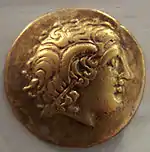Rauraci
The Rauraci or Raurici were a small Gallic tribe of the Iron Age and the Roman period.
Name
They are mentioned as Rauracis and Rauracorum by Caesar (mid-1st c. BC),[1] Raurici (var. -aci) by Pliny (1st c. AD),[2] and as Rauracense in the Notitia Dignitatum (5th c. AD).[3][4]
The ethnonym Rauraci derives from the ancient Celtic name of the river Ruhr, Raura.[5][6]
The city of Augst, attested in the 2nd century AD as Augoústa Rhauríkōn (Αὐγούστα Ῥαυρίκων), is indirectly named after the tribe.[4]
Geography
The Rauraci dwelled near the Tulingi, Latobici and Helvetii.[7] They were probably client of the larger Helvetii.[8] Their name seems to indicate that they originally lived by the river Ruhr.[6]
In 58 BC, they attempted a migration westward along with the Helvetii, but were repelled by the Romans. The Rauraci then settled between the Upper Rhine and the southern foothills of the Jura Massif, near the modern city of Basel.[7][8] Around that time, they built the oppidum of Basel-Münsterhügel, which became their chief town.[8]
In 44 BC, L. Munatius Plancus founded in their territory the colony of Augusta Raurica (modern Augst and Kaiseraugst).[7] The city was located at the crossroad of two strategic routes: between the Great St Bernard Pass and the Rhine, and between Gaul and the Danube. It reached 106ha at its height in 200 AD.[9] A great part of Augusta Raurica was destroyed by an earthquake in 240/250. Under Diocletian (284–295), it was incorporated into the province of Maxima Sequanorum. The Castrum Rauracense, erected in 290/300, became the core of the city in Late Antiquity.[10]
Another town, known as Argentovaria (modern Oedenburg, in Biesheim), was probably the capital of the civitas Rauricorum or of an unattested pagus of the Rauraci.[11]
Religion
The temple at the forum of Augusta Raurica was dedicated to Romae et Augusto. The temple of Schönbühl replaced indigenous shrines around 70 AD. Inscriptions give evidence of the Imperial cult and of dedications to various Graeco-Roman deities. Native Gaulish deities include Epona, Sirona and the quadruviae. The cult of the snake was popular in Augusta Raurica. The Oriental cults of Mithra, Sabatius and Harpocrates are also attested.[9]
References
- Caesar. Commentarii de Bello Gallico, 1:5:4, 1:29:2.
- Pliny. Naturalis Historia, 4:106.
- Notitia Dignitatum, 9:9.
- Falileyev 2010, s.v. Rauraci. and Col. Augusta Raurica.
- Lambert 1994, p. 34.
- Kruta 2000, p. 71.
- Walser 2006.
- Kruta 2000, p. 790.
- Schwarz 2004, p. 358.
- Schwarz 2004, p. 355.
- Schwarz 2010.
- Bibliography
- Falileyev, Alexander (2010). Dictionary of Continental Celtic Place-names: A Celtic Companion to the Barrington Atlas of the Greek and Roman World. CMCS. ISBN 978-0955718236.
- Kruta, Venceslas (2000). Les Celtes, histoire et dictionnaire : des origines à la romanisation et au christianisme. Robert Laffont. ISBN 2-221-05690-6.
- Lambert, Pierre-Yves (1994). La langue gauloise: description linguistique, commentaire d'inscriptions choisies. Errance. ISBN 978-2-87772-089-2.
- Schwarz, Peter-Andrew (2004). "Augst / Augusta Raurica (Suisse)". Supplément à la Revue archéologique du centre de la France. 25 (1): 355–359. ISSN 1951-6207.
- Schwarz, Peter-Andrew (2010). "Rauriker". Historisches Lexikon der Schweiz. 008022/2010-08-20.
- Walser, Gerold (2006). "Rauraci, Raurici". Brill’s New Pauly. doi:10.1163/1574-9347_bnp_e1019190.
